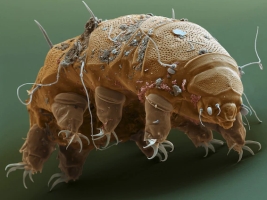  They have been found in very diverse regions of Earth – mountaintops, the deep sea, tropical rainforests, and the Antarctic. Tardigrades are among the hardiest animals known; some species can survive extreme temperatures, extreme pressures (both high and low), lack of air, radiation, dehydration, and starvation ... conditions that would kill most other forms of life. Tardigrades have survived exposure to outer space.
They have been found in very diverse regions of Earth – mountaintops, the deep sea, tropical rainforests, and the Antarctic. Tardigrades are among the hardiest animals known; some species can survive extreme temperatures, extreme pressures (both high and low), lack of air, radiation, dehydration, and starvation ... conditions that would kill most other forms of life. Tardigrades have survived exposure to outer space.Tardigrades are most common in moist environments, but can stay active wherever they can retain at least some moisture.  Their tubular mouths can pierce the plant cells, algae, or small invertebrates on which they feed, releasing the body fluids or cell contents. A short esophagus leads to an intestine that occupies most of the length of the body, which is the main site of digestion. The intestine opens to an anus located at the end of the body.
Their tubular mouths can pierce the plant cells, algae, or small invertebrates on which they feed, releasing the body fluids or cell contents. A short esophagus leads to an intestine that occupies most of the length of the body, which is the main site of digestion. The intestine opens to an anus located at the end of the body. Mating occurs when molting, with eggs being laid inside the shed skin of the female and then covered with sperm. Eggs hatch after about two weeks. Growth to adult size occurs by enlargement of individual cells, rather than by cell division. Tardigrades may molt up to 12 times. Tardigrades are one of the few species that can suspend their metabolism. While in this state, their metabolism lowers to less than 0.01% of normal and their water content can drop to 1%, and they can go without food or water for more than 30 years, after which they rehydrate, forage, and reproduce. In 2011, scientists sent tardigrades on board the International Space Station via the final flight of Space Shuttle Endeavour. Their conclusion was that microgravity and cosmic radiation "did not significantly affect survival of tardigrades in flight, and stated that tardigrades represent a useful animal for space research."   |